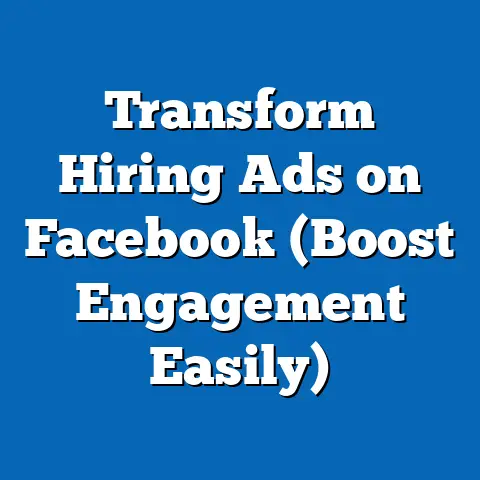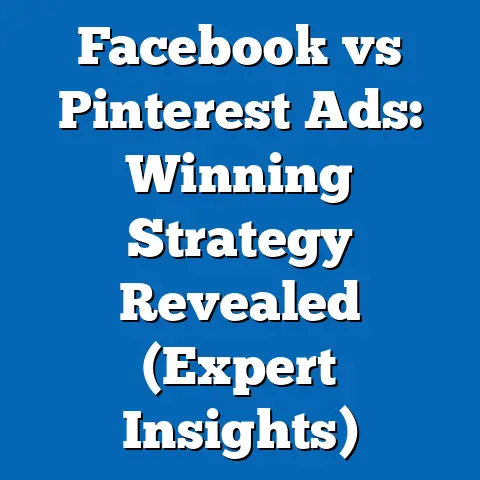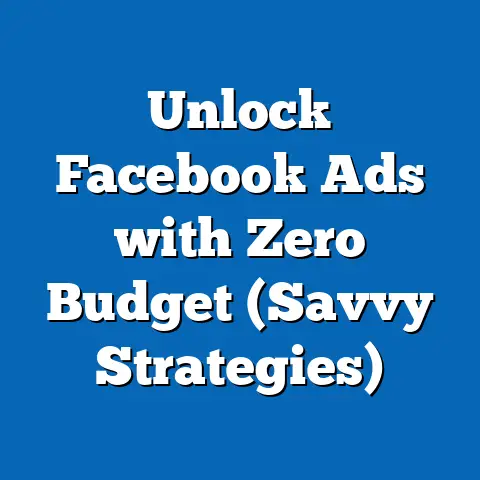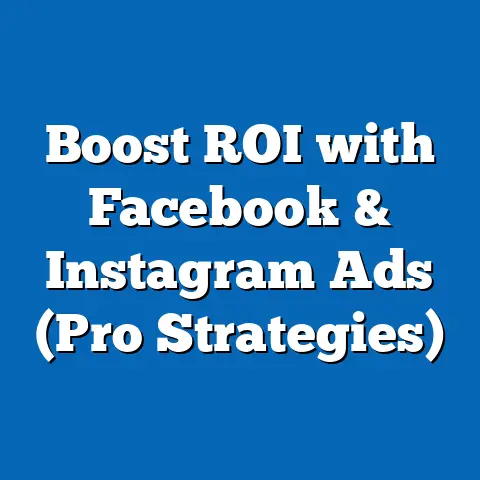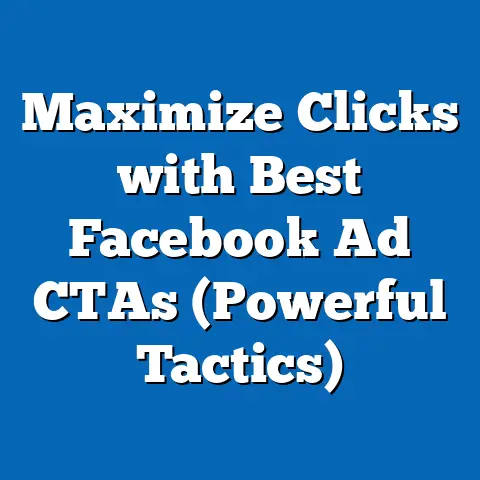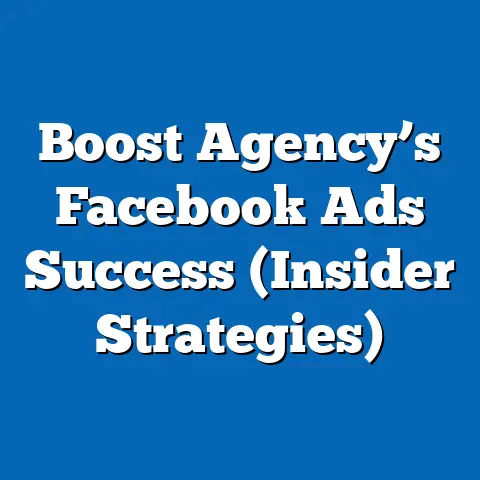Master Facebook Video Ad Safe Zone (Critical Insights)
Trends shift like sand. Adaptability is the name of the game. This is especially true in the realm of digital marketing, and even more so with Facebook advertising. Think about it: what worked last year might be obsolete today. Staying ahead means constantly learning, adapting, and tweaking your strategies.
I remember when I first started running Facebook video ads. I poured hours into crafting what I thought was the perfect video, only to find that crucial elements were cropped out on mobile devices! It was a frustrating lesson, but one that taught me the vital importance of understanding and respecting the platform’s guidelines.
The landscape of social media marketing is constantly evolving. Facebook, a giant in this realm, regularly updates its algorithms, ad formats, and user interface. As advertisers, we must keep pace with these changes to ensure our messages resonate with our target audience and don’t get lost in the noise.
This brings me to a critical concept: the “safe zone” in Facebook video ads. This is the area within your video frame where your key messaging, logos, and calls-to-action are guaranteed to be visible across all devices and screen sizes. Ignoring this safe zone can lead to a disastrous user experience, where crucial information is obscured or cropped out, rendering your ad ineffective.
In this article, I’m going to share critical insights that will enable you to master the safe zone in your Facebook video ads. I’ll walk you through understanding the current landscape, defining the safe zone, exploring design best practices, analyzing successful case studies, and anticipating future trends. By the end, you’ll have the knowledge and tools to create video ads that not only grab attention but also deliver your message effectively. Let’s dive in!
1. Understanding the Facebook Video Ad Landscape
Video content has exploded on Facebook, becoming a powerhouse for engaging audiences. It’s no longer enough to simply post a text update or a static image; video ads provide a dynamic and immersive experience that can capture attention and drive results.
The Rise of Video Content
Facebook has become a video-first platform. Users spend countless hours watching videos, from short, entertaining clips to longer, informative content. This shift in user behavior has made video ads an essential tool for marketers.
I’ve seen firsthand how video ads can outperform other formats. A client of mine, a local restaurant, saw a 30% increase in reservations after implementing a video ad campaign showcasing their signature dishes. The visual appeal of the food, combined with a compelling call-to-action, proved to be incredibly effective.
The Impact of Video Ads: Statistics Speak Volumes
Let’s look at some hard numbers to illustrate the impact of video ads:
- Engagement: Video ads generate significantly higher engagement rates compared to static images or text-based ads. According to a study by HubSpot, video posts on Facebook receive 59% more engagement than other post types.
- Conversion Rates: Video ads can dramatically improve conversion rates. A report by WordStream found that video ads have a 34% higher conversion rate than other ad formats.
- Mobile Dominance: Mobile is where video thrives. Over 98% of Facebook users access the platform via mobile devices, making it crucial to optimize video ads for mobile viewing.
- Attention Span: While user attention spans are shrinking, compelling video content can still hold attention. Facebook reports that people spend an average of 5 times longer watching video than looking at static content on Facebook and Instagram.
These statistics clearly demonstrate the power of video ads in capturing attention, driving engagement, and ultimately, boosting conversions.
Navigating the Different Video Ad Formats
Facebook offers a variety of video ad formats, each with its unique strengths and use cases:
- In-Feed Videos: These are the most common type of video ad, appearing directly in users’ news feeds alongside organic content. They are ideal for capturing attention and driving brand awareness.
- Stories: Facebook Stories are short, vertical videos that disappear after 24 hours. They are perfect for creating a sense of urgency and exclusivity, and are often used for behind-the-scenes content or limited-time offers.
- Carousel Ads: Carousel ads allow you to showcase multiple videos (or images) in a single ad unit. This format is great for telling a story, highlighting different product features, or showcasing a variety of offerings.
- Instant Experience Ads: These are full-screen, mobile-optimized experiences that load instantly when a user clicks on an ad. They can include a combination of videos, images, and text, providing a highly immersive and engaging experience.
- Collection Ads: Collection ads are designed for e-commerce businesses, allowing users to browse and purchase products directly from the ad. They typically feature a main video or image, along with a selection of related products.
- In-Stream Video Ads: These are ads that play before, during, or after other video content on Facebook. They can be a good option for reaching a specific audience that is already engaged with video content.
Choosing the right ad format depends on your specific goals, target audience, and the type of content you want to share.
The Algorithm and User Behavior: Adapting to Change
Facebook’s algorithm is constantly evolving, and user behavior is shifting just as rapidly. Understanding these changes is crucial for creating effective video ads.
- Algorithm Updates: Facebook’s algorithm prioritizes content that is engaging, relevant, and valuable to users. This means that video ads need to be high-quality, visually appealing, and targeted to the right audience.
- Mobile-First Mentality: With the majority of users accessing Facebook on mobile devices, it’s essential to design video ads with a mobile-first approach. This means optimizing for vertical viewing, using clear and concise messaging, and ensuring that your video loads quickly.
- Sound-Off Viewing: Many users watch videos on Facebook with the sound off, especially in public places. This means that your video ads need to be visually compelling and easy to understand, even without audio. Consider using captions or on-screen text to convey your message.
Key Takeaway: The Facebook video ad landscape is dynamic and ever-changing. By understanding the different ad formats, staying informed about algorithm updates, and adapting to user behavior, you can create video ads that capture attention, drive engagement, and achieve your marketing goals.
Next Steps: Familiarize yourself with the different Facebook video ad formats and experiment with each to see which performs best for your business. Stay up-to-date on Facebook’s algorithm updates and adjust your strategies accordingly. Always prioritize mobile-first design and consider sound-off viewing when creating your video ads.
2. The Concept of Safe Zone in Video Ads
Now that we’ve established the importance of video ads on Facebook, let’s dive into the concept of the “safe zone.” This is a critical aspect of video ad design that often gets overlooked, but it can significantly impact the effectiveness of your campaigns.
Defining the Safe Zone
In the context of Facebook video ads, the “safe zone” refers to the area within your video frame where your key visual elements, such as logos, text, and calls-to-action, are guaranteed to be visible across all devices and screen sizes. It’s essentially a buffer zone that protects your critical messaging from being cropped out or obscured.
Think of it like this: imagine you’re designing a poster, but you don’t know the exact dimensions of the frames it will be placed in. To ensure that your message is always visible, you would need to keep your key elements within a certain area, away from the edges. That’s essentially what the safe zone does for video ads.
Why the Safe Zone Matters
Ignoring the safe zone can lead to a number of problems:
- Cropped-Out Content: On smaller screens or devices with different aspect ratios, elements that are too close to the edges of your video may be cropped out, leaving viewers with an incomplete or confusing message.
- Obscured Text: Text that is placed outside the safe zone may be obscured by interface elements, such as profile pictures, page names, or call-to-action buttons. This can make it difficult for viewers to understand your message.
- Branding Issues: If your logo is placed outside the safe zone, it may not be visible on all devices, weakening your brand recognition.
- Poor User Experience: A poorly designed video ad that ignores the safe zone can create a frustrating user experience, leading viewers to scroll past your ad or even negatively impacting their perception of your brand.
Dimensions and Placement: Getting It Right
Facebook recommends keeping all key elements within the following safe zone dimensions:
- For 1:1 (Square) Videos: Keep your text and logos within 83% of the height and width of the video frame. This means leaving a 8.5% buffer on all sides.
- For 4:5 (Vertical) Videos: Keep your text and logos within 75% of the height and width of the video frame. This means leaving a 12.5% buffer on all sides.
- For 9:16 (Full-Screen Vertical) Videos: Keep your text and logos within 56% of the height and width of the video frame. This means leaving a 22% buffer on all sides.
These are general guidelines, and it’s always a good idea to test your videos on different devices to ensure that everything looks as intended.
Visual Examples: Safe Zone Success vs. Failure
Let’s look at some examples to illustrate the importance of the safe zone:
Example 1: Safe Zone Success
Imagine a video ad for a new mobile game. The logo, game title, and call-to-action (“Download Now”) are all placed within the recommended safe zone. Regardless of the device or screen size, these key elements are always visible, ensuring that viewers understand the message and know how to take action.
Example 2: Safe Zone Failure
Now imagine a video ad for a clothing brand. The logo is placed in the upper-left corner of the video, and some of the text is placed near the bottom edge. On smaller screens, the logo is partially cropped out, and the text is obscured by the Facebook interface. Viewers may not even realize which brand is advertising, and they may miss the key details about the product.
Ensuring Visibility Across Devices
The safe zone helps advertisers ensure that their key messages, logos, and calls-to-action remain visible across various devices and screen sizes. This is especially important in today’s mobile-first world, where users are consuming content on a wide range of devices, from smartphones to tablets to laptops.
By respecting the safe zone, you can create video ads that look great and perform well on all devices, regardless of screen size or aspect ratio. This ensures that your message is always clear, concise, and impactful.
Key Takeaway: The safe zone is a critical aspect of Facebook video ad design that ensures your key messaging is visible across all devices. Ignoring the safe zone can lead to cropped-out content, obscured text, branding issues, and a poor user experience.
Next Steps: Familiarize yourself with the recommended safe zone dimensions for different video aspect ratios. Use these guidelines when designing your video ads, and always test your videos on different devices to ensure that everything looks as intended.
3. Best Practices for Designing Video Ads within the Safe Zone
Now that we understand the importance of the safe zone, let’s explore some best practices for designing video ads that maximize its effectiveness. This section will cover design principles, storytelling techniques, and a step-by-step guide to storyboarding your video ads.
Design Principles: Color, Typography, and Imagery
The visual elements of your video ad play a crucial role in capturing attention and conveying your message. Here are some design principles to keep in mind:
- Color Choices: Choose colors that are visually appealing and consistent with your brand. Consider using contrasting colors to make your text and call-to-action stand out. Be mindful of accessibility; ensure sufficient contrast between text and background for readability.
- Typography: Use clear and legible fonts that are easy to read on small screens. Avoid using overly decorative fonts that can be distracting. Consider using different font weights and sizes to create visual hierarchy and emphasize key messages.
- Imagery: Use high-quality images and videos that are relevant to your message. Avoid using stock photos that look generic or unauthentic. Consider using animation or motion graphics to add visual interest.
I’ve found that simplicity is often key. A video ad with a clear, concise message and visually appealing design is more likely to capture attention and drive results than a cluttered or confusing ad.
Branding: Capture Attention Early
Incorporating branding elements early in your video ad is crucial for capturing viewer attention and building brand recognition. Here are some tips:
- Logo Placement: Place your logo within the safe zone, preferably in a prominent location such as the upper-left or upper-right corner of the video.
- Brand Colors: Use your brand colors throughout the video to create a consistent visual identity.
- Brand Messaging: Incorporate your brand messaging into the video script and on-screen text.
- Subtle Integration: Integrate your branding elements subtly and naturally, without being overly intrusive or distracting.
I’ve seen many brands make the mistake of burying their logo at the end of their video ad. By that point, many viewers have already scrolled past, missing the opportunity to connect the message with the brand.
Storytelling: Crafting Narratives That Resonate
Storytelling is a powerful tool for engaging audiences and making your video ads more memorable. Here are some tips for crafting narratives that fit within the safe zone:
- Keep It Short and Sweet: Facebook video ads are typically short, so you need to tell your story concisely. Aim for a video length of 15-30 seconds.
- Focus on a Single Message: Don’t try to cram too much information into your video ad. Focus on a single, clear message that resonates with your target audience.
- Use Visual Storytelling: Use visuals to tell your story, rather than relying solely on dialogue or narration.
- Create an Emotional Connection: Connect with your audience on an emotional level by telling a story that is relatable, inspiring, or entertaining.
- Hook Them Early: Capture attention within the first few seconds to prevent viewers from scrolling past.
Storyboarding: A Step-by-Step Guide
Storyboarding is a powerful technique for planning and visualizing your video ad before you start filming or animating. Here’s a step-by-step guide:
- Define Your Goal: What do you want to achieve with your video ad? Do you want to increase brand awareness, drive traffic to your website, or generate leads?
- Identify Your Target Audience: Who are you trying to reach with your video ad? What are their interests, needs, and pain points?
- Develop Your Message: What is the key message you want to convey in your video ad? Keep it simple, clear, and concise.
- Create a Script: Write a script that outlines the dialogue, narration, and on-screen text for your video ad.
- Sketch Your Storyboard: Create a series of sketches that illustrate the key scenes and visuals in your video ad.
- Plan Your Safe Zone: Identify the areas where you will place your logo, text, and call-to-action, ensuring that they are within the recommended safe zone dimensions.
- Review and Revise: Review your storyboard with your team and make any necessary revisions.
Key Takeaway: Designing effective video ads within the safe zone requires a combination of design principles, storytelling techniques, and careful planning. By focusing on clear messaging, visually appealing design, and emotional connection, you can create video ads that capture attention and drive results.
Next Steps: Experiment with different design elements, storytelling techniques, and storyboarding methods to find what works best for your brand. Always test your video ads on different devices to ensure that they look great and perform well across all platforms.
4. Analyzing Successful Case Studies
To further illustrate the importance of mastering the safe zone in Facebook video advertising, let’s examine some successful case studies. By analyzing the strategies and tactics employed by these brands, we can gain valuable insights and inspiration for our own campaigns.
Case Study 1: Dollar Shave Club
Dollar Shave Club is a subscription-based razor and grooming company that has built a strong brand presence through clever and humorous video advertising. Their Facebook video ads often feature witty scripts, engaging visuals, and a clear call-to-action.
- Hook Strategy: Dollar Shave Club’s video ads typically start with a humorous hook that grabs viewers’ attention within the first few seconds.
- Emotional Resonance: Their ads often tap into the frustrations and pain points of their target audience, such as the high cost of razors or the inconvenience of buying them in stores.
- Call-to-Action Placement: The call-to-action (“Join Now”) is prominently displayed within the safe zone, making it easy for viewers to take action.
- Metrics: Dollar Shave Club has seen significant success with their Facebook video ads, generating high engagement rates, click-through rates, and conversion rates.
Case Study 2: Airbnb
Airbnb is a platform that connects travelers with hosts offering unique accommodations around the world. Their Facebook video ads often showcase stunning visuals of their properties, along with heartwarming stories of travelers and hosts.
- Hook Strategy: Airbnb’s video ads often start with captivating visuals of their properties, immediately drawing viewers in.
- Emotional Resonance: Their ads often tell stories that evoke feelings of wanderlust, adventure, and connection.
- Call-to-Action Placement: The call-to-action (“Book Now”) is strategically placed within the safe zone, making it easy for viewers to browse and book their next trip.
- Metrics: Airbnb has seen significant success with their Facebook video ads, driving traffic to their website, increasing bookings, and building brand awareness.
Case Study 3: Nike
Nike is a global athletic apparel and footwear brand that has built a strong brand presence through inspiring and motivational video advertising. Their Facebook video ads often feature athletes overcoming challenges and achieving their goals.
- Hook Strategy: Nike’s video ads often start with powerful visuals and inspiring music, immediately capturing viewers’ attention.
- Emotional Resonance: Their ads often tap into the emotions of their target audience, such as determination, perseverance, and the pursuit of excellence.
- Call-to-Action Placement: The call-to-action (“Shop Now”) is strategically placed within the safe zone, making it easy for viewers to browse and purchase their products.
- Metrics: Nike has seen significant success with their Facebook video ads, driving traffic to their website, increasing sales, and building brand loyalty.
Analyzing Success: Key Elements
By analyzing these successful case studies, we can identify some key elements that contribute to their effectiveness:
- Compelling Hook: A strong hook that grabs viewers’ attention within the first few seconds.
- Emotional Resonance: A story that connects with the audience on an emotional level.
- Clear Call-to-Action: A prominent and easy-to-find call-to-action that encourages viewers to take action.
- Safe Zone Compliance: All key elements, such as logos, text, and calls-to-action, are placed within the recommended safe zone dimensions.
- High-Quality Visuals: Stunning visuals that are relevant to the message and consistent with the brand.
Unique Strategies: Inspiration for Readers
These brands have also employed some unique strategies that can serve as inspiration for readers:
- Dollar Shave Club: Humor and wit to capture attention and build brand personality.
- Airbnb: Heartwarming stories to evoke feelings of wanderlust and connection.
- Nike: Inspiring and motivational content to tap into the emotions of their target audience.
Key Takeaway: Analyzing successful case studies can provide valuable insights and inspiration for your own Facebook video advertising campaigns. By studying the strategies and tactics employed by these brands, you can learn how to create video ads that capture attention, drive engagement, and achieve your marketing goals.
Next Steps: Research other successful Facebook video advertising campaigns in your industry. Identify the key elements that contribute to their effectiveness and adapt those strategies to your own campaigns.
5. Future Trends and Adaptation Strategies
The world of Facebook advertising is constantly evolving, with new trends and technologies emerging all the time. To stay ahead of the curve, it’s essential to anticipate these changes and adapt your strategies accordingly.
Emerging Trends: AR and Interactive Video
Some of the emerging trends in video advertising on Facebook include:
- Augmented Reality (AR): AR allows users to overlay digital content onto the real world using their smartphones or tablets. This technology can be used to create interactive and engaging video ads that allow users to try on products, explore virtual environments, or play games.
- Interactive Video: Interactive video allows viewers to interact with the video content, such as clicking on buttons, answering questions, or exploring different scenarios. This technology can be used to create more engaging and personalized video ads that capture viewers’ attention and drive conversions.
- Personalized Video: Personalized video allows you to tailor your video ads to individual viewers based on their demographics, interests, or past behavior. This technology can be used to create more relevant and engaging video ads that resonate with your target audience.
I’m particularly excited about the potential of AR in video advertising. Imagine being able to virtually “try on” a pair of glasses or see how a piece of furniture would look in your home, all through a Facebook video ad!
Adapting to Changes in User Behavior
User behavior is also constantly evolving, so it’s important to stay informed about these changes and adapt your strategies accordingly.
- Shorter Attention Spans: User attention spans are shrinking, so you need to capture their attention quickly and keep your video ads short and concise.
- Mobile-First Viewing: Most users are watching videos on mobile devices, so you need to optimize your video ads for mobile viewing.
- Sound-Off Viewing: Many users are watching videos with the sound off, so you need to make your video ads visually appealing and easy to understand without audio.
- Increased Privacy Concerns: Users are becoming more concerned about their privacy, so you need to be transparent about how you are using their data and respect their privacy preferences.
The Evolving Algorithms of Facebook
Facebook’s algorithm is constantly evolving, so it’s important to stay informed about these changes and adjust your strategies accordingly.
- Prioritizing Meaningful Interactions: Facebook’s algorithm prioritizes content that fosters meaningful interactions between users. This means that your video ads need to be engaging, relevant, and valuable to your target audience.
- Combating Misinformation: Facebook is actively combating misinformation, so you need to ensure that your video ads are accurate and truthful.
- Promoting Transparency: Facebook is promoting transparency in advertising, so you need to be clear about who you are and what you are advertising.
Staying Vigilant and Proactive
To succeed in the ever-changing world of Facebook advertising, you need to remain vigilant and proactive. This means staying informed about the latest trends and technologies, adapting your strategies accordingly, and continuously testing and optimizing your campaigns.
I’ve learned that the best way to stay ahead of the curve is to constantly experiment and learn from my mistakes. Don’t be afraid to try new things and see what works best for your brand.
Key Takeaway: The future of Facebook advertising is dynamic and uncertain. By staying informed about emerging trends, adapting to changes in user behavior, and understanding the evolving algorithms of Facebook, you can position yourself for success in the years to come.
Next Steps: Research the latest trends and technologies in video advertising. Experiment with new ad formats and features. Continuously test and optimize your campaigns to improve performance.
Conclusion
Mastering the safe zone in Facebook video ads is essential for maximizing the impact of your campaigns. Throughout this article, I’ve shared critical insights into understanding the Facebook video ad landscape, defining the safe zone, exploring design best practices, analyzing successful case studies, and anticipating future trends.
Remember, the world of digital marketing is constantly evolving, and adaptability is key to success. By staying informed, experimenting with new strategies, and continuously optimizing your campaigns, you can create video ads that capture attention, drive engagement, and achieve your marketing goals.
As you embark on your Facebook advertising journey, remember that the potential for success lies in embracing change and continuously learning. The strategies that work today may not work tomorrow, so it’s important to remain vigilant and proactive in your approach.
The future of advertising is uncertain, but one thing is clear: those who are willing to adapt and embrace change will be the ones who thrive. So, go forth, experiment, and create amazing video ads that resonate with your audience and drive results. Good luck!

